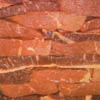Luasa Raelon, "The House of Flesh"
 David Reed's latest as Luasa Raelon shares more with his Envenomist namesake, filled as it is with lonesome and metallic drones. In The House of Flesh there is no soul and whatever is left in its absence is a bleak and threatening specter.
David Reed's latest as Luasa Raelon shares more with his Envenomist namesake, filled as it is with lonesome and metallic drones. In The House of Flesh there is no soul and whatever is left in its absence is a bleak and threatening specter.
Snip Snip
A grotesque pile of meat adorns the cover to Luasa Raelon's latest album. This lifeless arrangement of tissue communicates perfectly the various tones and distorted synthetic sounds that populate much of The House of Flesh. Piled one on top of the other, Reed's machines generate a buzzing mass of atonal filth infused with frigid details. Glacial slabs of sound creak and grate against each other producing an air of emptiness; one would expect some substance beneath their surface, but Reed annihilates anything deeper than the superficial breeze of synthesized sine waves. The music is abrupt and clinical, sometimes sounding incomplete or sterile. This compositional approach is, at times, frustrating, but it produces genuinely desolate music of a frightening quality. Whether or not it is enjoyable is a different question, however, and I'm suspicious of Reed's intent on this record.
The album is divided into nine distinct cuts. These pieces begin and end as individual songs, but I am inclined to believe that each one was cut from the same extended and unedited work. There are pieces on the record that feature more distinct qualities than others, but none of them play host to any of the defining characteristics that typically set one song or piece apart from another. Songs like "Welcome to the House" and "These Rooms Are Alive" are distinct enough as movements but do not sound to me like whole entities in and of themselves. This amplifies the fragmented, detached nature of the album, but simultaneously disturbs its sometimes pleasant continuity. Among these dead noises there are blissful moments, but perhaps Reed aimed to avoid such pleasantries. Unexpected silences and sudden fades often end these songs, lending credence to the idea that the sequencing was designed to make an uncomfortable record all the more awkward. The House of Flesh can be listened to and appreciated, but that does not make it a pleasant or enjoyable album. It is an odd and unquiet record that squirms with a nervous and unsettling energy and obviates certain customs to which it pretends adherence. Even for Reed this is a strange and inexplicable recording.
samples:



